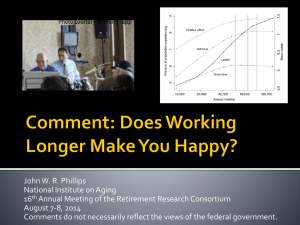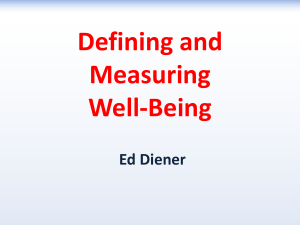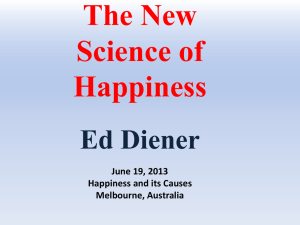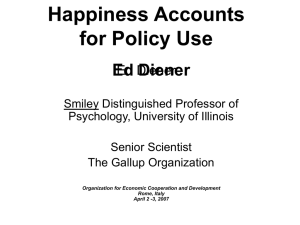Research Report - Scott Barry Kaufman
advertisement
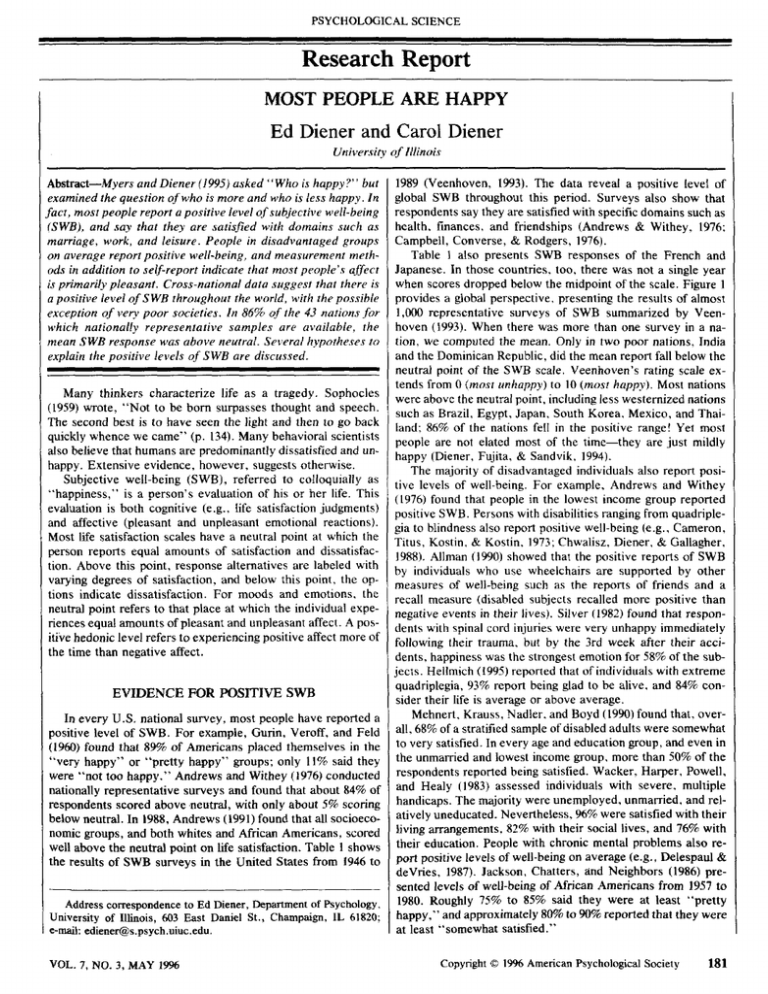
PSYCHOLOGICAL SCIENCE
Research Report
MOST PEOPLE ARE HAPPY
Ed Diener and Carol Diener
University of Illinois
Abstract—Myers and Diener (1995) asked "Who is happy?" but
examined the question of who is more and who is less happy. In
fact, most people report a positive level of subjective well-being
(SWB), and say that they are satisfied with domains such as
marriage, work, and leisure. People in disadvantaged groups
on average report positive well-being, and measurement methods in addition to self-report indicate that most people's affect
is primarily pleasant. Cross-national data suggest that there is
a positive level of SWB throughout the world, with the possible
exception of very poor societies. In 86% of the 43 nations for
which nationally representative samples are available, the
mean SWB response was above neutral. Several hypotheses to
explain the positive levels of SWB are discussed.
Many thinkers characterize life as a tragedy. Sophocles
(1959) wrote, "Not to be born surpasses tbought and speecb.
The second best is to have seen tbe light and then to go back
quickly whence we came" (p. 134). Many behavioral scientists
also believe that humans are predominantly dissatisfied and unhappy. Extensive evidence, bowever, suggests otherwise.
Subjective well-being (SWB), referred to colloquially as
"happiness," is a person's evaluation of his or her life. This
evaluation is both cognitive (e.g., iife satisfaction judgments)
and affective (pleasant and unpleasant emotional reactions).
Most life satisfaction scales have a neutral point at which the
person reports equal amounts of satisfaction and dissatisfaction. Above tbis point, response alternatives are labeled with
varying degrees of satisfaction, and below tbis point, the options indicate dissatisfaction. Eor moods and emotions, tbe
neutral point refers to that place at which tbe individual experiences equal amounts of pleasant and unpleasant affect. A positive hedonic level refers to experiencing positive affect more of
the time than negative affect.
EVIDENCE FOR POSITIVE SWB
In every U.S. national stirvey, most people have reported a
positive level of SWB. Eor example, Gurin, Veroff, and Eeld
(1960) found that 89% of Americans placed themselves in the
"very happy" or "pretty happy" groups; only 11% said they
were "not too happy." Andrews and Withey (!976) conducted
nationally representative surveys and found that about 84% of
respondents scored above neutral, with only about 5% scoring
below neutral. In 1988, Andrews (1991) found that all socioeconomic groups, and both whites and African Americans, scored
well above tbe neutral point on life satisfaction. Table 1 shows
the restilts of SWB surveys in the United States from J946 to
Address correspondence to Ed Dietier, Departmetit of Psychology,
University of IUitiois, 603 East Daniel St., Champaign, IL 61820;
e-tnail: ediener@s.psych.uiuc.edu.
VOL. 7, NO. 3, MAY 1996
1989 (Veenhoven, 1993). The data reveal a positive level of
global SWB throughout this period. Surveys also show that
respondents say they are satisfied with specific domains such as
healtb, finances, and friendships (Andrews & Withey, 1976;
Campbell, Converse, & Rodgers, 1976).
Table \ also presents SWB responses of tbe Erench and
Japanese. In those countries, too, there was not a single year
when scores dropped below the midpoint of tbe scale. Eigure 1
provides a global perspective, presenting the results of almost
1,000 representative surveys of SWB summarized by Veenhoven (1993). When there was more tban one survey in a nation, we computed the mean. Only in two poor nations, India
and the Dominican Republic, did the mean report fall below the
neutral point of the SWB scale. Veenhoven's rating scale extends from 0 {most unhappy) to 10 (most happy). Most nations
were above the neutral point, including less westernized nations
such as Brazil, Egypt, Japan, South Korea, Mexico, and Thailand; 86% of the nations fell in the positive range! Yet most
people are not elated most of tbe time—tbey are just mildly
happy (Diener, Eujita, & Sandvik, 1994).
The majority of disadvantaged individuals also report positive levels of well-being. Eor example, Andrews and Withey
(1976) found that people in tbe lowest income group reported
positive SWB. Persons with disabilities ranging from quadriplegia to blindness also report positive well-being (e.g., Cameron,
Titus, Kostin, & Kostin, 1973; Chwalisz, Diener, & Gallagher,
1988). Allman (1990) showed tbat tbe positive reports of SWB
by individuals who use wheelchairs are supported by other
measures of well-being such as tbe repotts of friends and a
recall measure (disabled subjects recalled more positive than
negative events in their lives). Silver (1982) found that respondents with spinal cord injuries were very unhappy immediately
following their trauma, but by the 3rd week after their accidents, happiness was the strongest emotion for 58% of the subjects. Hellmich (1995) reported that of individuals with extreme
quadriplegia, 93% report being glad to be alive, and 84% consider their life is average or above average.
Mehnert, Krauss, Nadler, and Boyd (1990) found that, overall, 68% of a stratified sample of disabled adults were somewhat
to very satisfied. In every age and education group, and even in
the unmarried and lowest income group, more tban 50% of tbe
respondents reported being satisfied. Wacker, Harper, Powell,
and Healy (1983) assessed individuals with severe, multiple
handicaps. The majority were unemployed, unmarried, and relatively uneducated. Nevertheless, 96% were satisfied witb tbeir
living arrangements, 82% with their social lives, and 76% with
their education. People with chronic mental problems also report positive levels of well-being on average (e.g., Delespatil &
deVries, 1987). Jackson, Chatters, and Neighbors (1986) presented levels of well-being of African Americans from 1957 to
1980. Roughly 75% to 85% said they were at least "pretty
happy," and approximately 80% to 90% reported that they were
at least "somewhat satisfied."
Copyright © 19% American Psychological Society
181
PSYCHOLOGICAL SCIENCE
Subjective Weil-Being
Tabk 1, Time trends in subjective well-being
Year
1946
1947
1948
1952
1956
1957
1958
1959
1960
United States
Japan
Erance
7.4
7.4
7.3
7.6
7.8
7.9
—
5.5
—
5,9
1963
1964
1965
1966
1967
7.7
7.4
7.0
7.5
1970
1971
1972
1973
1974
1975
1976
1977
1978
1979
1980
1981
1982
1983
1984
1985
1986
1987
1988
1989
1990
1991
1992
7.5
7.2
7.0
7.0
7,2
7.4
7.3
7.3
7.2
7.2
7.2
7.3
7.2
7.2
7.2
7.4
7.3
—
5.7
6.0
5.9
5.9
5.9
6.1
5.9
5.8
5.8
5.9
6.0
5.9
6.0
5.7
5.8
5.9
5.4
5.7
5.8
6.0
6.0
6.1
5.9
5.9
6.0
6.0
6.0
6.2
5.9
—
—
—
—
6.3
—
—
—
—
—
—
6.2
—
6.3
6.2
6.5
6.2
6.6
5.8
5.9
6.4
6.3
6.3
6.4
6.4
5.7
5.5
6.2
6,0
6.0
6.0
Note. This table is based on data summarized by
Veenhoven (1993). The life satisfactioti atid
happiness scales used ranged from 0 to 10, with 5 as
the tieutral midpoint.
METHODOLOGICAL EXPLANATIONS
Most surveys ask people on one occasion to report orally
how happy or satisfied they are, often on a single-item scale.
Might tbis measurement situation be biased toward positive responding? (Eor a more complete discussion of problems in measuring SWB, see Diener, 1994.) SWB scales show good levels of
validity (e.g., Andrews & Withey, 1976; Diener, 1984) and correlate highly with non-self-report measures of SWB (Sandvik,
Diener, & Seidlitz, 1993). Nevertheless, Kahneman, Eredrick-
182
Fig, 1. Distribution of mean subjective well-being responses for
43 nations. Tbe mean of the nations' means is 6.33 on a scsile
from 0 {most unhappy) to 10 (^most happy).
son, Schreiber, and Redelmeier (1993) showed that global reports may not accurately reflect on-line experience, and
Schwarz and Strack (1991) found that global reports are influenced by situational factors. Thus, it is important to review
evidence that other methods of measurement also produce positive estimates of SWB.
There are several methods of measuring SWB that do not
rely on global self-reports of well-being. These methods indicate that the high rates of positive well-being found witb onetime self-report measures are not due to measurement artifacts.
Table 2 presents data collected in our laboratory from five samples. In addition to collecting self-report data, we collected data
from target respondents' family members and friends, who
completed the scales as they thought the target respondents
would. The studies also included an experience-sampling measure on which subjects reported their moods each day over a
period of many weeks. Einally, in the memory balance measure, participants were asked to recall as many positive events
and negative events from their lives as they could in separate
timed periods (SeidUtz & Diener, 1993).
Table 2 shows tbe percentages of respondents who scored
above the neutral point on each measure. As can be seen, most
respondents in all samples and on all measures scored in the
positive range. On the daily experience-sampling measure, the
numbers shown are the percentages of individuals who reported
more positive than negative affect on more than half of the days
sampled. Experience sampling may be the best measure of longterm affect, and on this measure a very small number of respondents were unhappy. The memory balance figures refer to the
percentage of individuals in each sample who could remember
more positive than negative life events, and indicate that most
people remembered more good than bad events in their lives.
The data in Table 2 lead to the conclusion that whatever shortVOL. 7, NO. 3, MAY 19%
PSYCHOLOGICAL SCIENCE
Ed Diener atid Carol Diener
Table 2. Percentage of participants with positive subjective welt-being in multimethod studies
Student samples
Measure"
One-time self-report
Deiighted-Terrible (Above 4)
Satisfaction With Life Scale (Above 20)
Eordyce (Above 5)
Mood Adjectives (Above 0)
Family members and friends
Satisfaction With Life Scale (Above 20)
Eordyce (Above 5)
Mood Adjectives (Above 0)
Daily experience sampling
(More than 50% positive days)
Memory balance
(Remembered more positive
than negative days)
Otber samples
Elderly
(N = 39)
Mixed adults
{N = 109)
1986
(N = 130)
1991-1992
(N = 222)
Disabled
(N = 58)
74
78
93
90
64
63
87
97
79
72
93
85
98
84
97
98
66
93
92
98
95
78
—
71
79
72
74
63
64
85
97
59
65
94
67
87
94
^'Delighted-Terrible (Andrews & Withey. 1976) is a 7-point scale, with a neutral midpoint of 4. The Satisfaction With Life Scale (Pavot
& Diener 1993) is a 5-item scale answered on a l-to-7 format. Scores range from 5 to 35, with a neutral point of 20. The Eordyce score
is from the Eordyce (1988) 60-s scale of happiness. Its neutral midpoint is 5. The Mood Adjectives score mdicates mtensity of response
to mood adjectives; the table presents the percentages of people who showed on average more intense reports to positive mood words
(e.g.. joyful) than negative mood words (e.g.. sadness).
comings self-reports may possess, they do not seem to lead to
excessively high estimates of happiness compared with other
methods.
In the experience-sampling method, participants are signaled
at random moments during the day and are asked to record their
mood. In two other studies (Thomas & Diener, 1990), college
students who were "beeped" reported more positive affect
than negative affect on about 80% of occasions. Similarly,
Williams, Suls, Alliger, Learner, and Choi (1991) found that
working mothers who were signaled at random times reported
very high levels of positive affect and low levels of negative
affect. Larson (1989) used the beeper methodology with American children; they reported predominantly positive affect about
52% of the time, neutral or mixed affect on about 29% of tbe
occasions, and dominant negative affect 19% of tbe time.
Brandstatter (1991) drew his respondents in Europe from
unemployed persons, soldiers, students, married couples, and
members of charity organizations. Participants recorded a selfselected word that described their current mood when they
were signaled. Joy and relaxation were reported 43% of the
time, and sadness, anger, and fear were reported 22% of the
time. On average, respondents reported positive emotions 68%
of the time.
Diener, Larsen, and Emmons (1984) examined subjects' levels of mood in different situations. The moods ranged from
slightly positive, when respondents were alone, to extremely
positive, when participants were in social, recreational situations. Einally, Delespaui and deVries (1987) studied chronic
mental patients living in the community and found that the average mood at the time these patients were signaled was above
the neutral point of the scale. Thus, on-line experienceVOL. 7, NO. 3, MAY 1996
sampling studies as well as other methods suggest levels of
SWB that are as high as those obtained by global self-reports.
COGNITIVE EVIDENCE
Cognitions tend to be positive. Matlin and Stang (1978) reviewed a myriad of positive cognitive tendencies: People think
positive thoughts more often than negative thoughts and are
more likely to recall positive than negative material. People can
use downward comparison (Crocker, Thompson, McGraw, &
Ingerman, 1987) to boost their positive affect. Tbere is strong
evidence that most people believe they are better than average
on most dimensions (e.g., Headey & Wearing, 1988; Taylor &
Brown, 1988). Seidlitz (1993) found that most people can recall
positive events from their lives more quickly than negative
events. Optimistic cognitions can lead to increased SWB, and
the average person appears to be prone to optimism (Tiger,
1979). Because cognition and emotion are so intimately intertwined, the strong evidence for a positive predilection in cognition supports the finding that most people experience predominantly positive affect.
ESTIMATES OE SWB
In order to determine whether the high well-being reported
by most people is intuitively obvious, we surveyed several
groups: working adults, undergraduate psychology majors, and
clinical psychology graduate students. They estimated the rates
of depression and life satisfaction in the United States and answered other questions related to SWB. The percentages in
Tables 3 and 4 reveal that all groups underestimated levels of
183
PSYCHOLOGICAL SCIENCE
Subjective Weil-Being
Table 3. Means of percentage estimates of subjective
well-being
Respondent group
Question
What percentage of Americans become clinically
depressed in their lifetime?
What percentage of Americans report positive life
satisfaction (above neutral)?
What percentage of chronic nonhospitalized mental
patients report a positive hedonic balance (more positive
affect than negative affect)?
life satisfaction and overestimated levels of depression. The
unhappiness of unemployed men and chronic mental patients
was overestimated. Thus, the high levels of well-being reported
in this article are not widely recognized by laypersons or by
students of psychology.
Indeed, it is so amazing to some people that quadriplegics
and other people with severe disabilities could be happy that
their self-reports are sometimes dismissed as unbelievable. It
should be noted, however, that individuals who use wheelchairs
are believed to be happy by their friends and family, can recall
more good than bad events in their lives, are rated as happy by
an interviewer, and report more positive than negative emotions in daily experience-sampling measures (Allman, 1990).
Our personal experience as acquaintances of people with severe
handicaps also indicates that they do indeed often find positive
meaning and pleasures in life.
THEORETICAL EXPLANATIONS
One hypothesis is that there is a positive baseline for affect
in humans. Headey and Wearing (1992) proposed a theory in
which people move back toward a personal base level of affect
after positive or negative events move them away from this
baseline. Although the set point varies depending on a person's
Table 4. Percentage of respondents
mostly unhappy
who estimated
Working
adults
{N = 29)
Psychology
majors
(N = 44)
Clinical
graduate
students
{N = 15)
Correct
response
49
50
24
8-18
56
61
48
82-84
33
34
24
57
temperament and socialization, for most people it appears to be
in the positive range. We speculate that the set point for affect
may be positive rather than neutral or negative for several reasons. First, a positive set point gives negative events maximum
informational value because they stand out as figure against a
positive background (Schwartz & Garamoni. 1986). A system
that is preset to be slightly positive allows threatening events to
be noticed quickly.
Second, it is important for motivational reasons that people
not be in a negative mood most of the time. Approach tendencies must prevail in behavior for people to obtain food, shelter,
social support, sex, and so forth. Because positive moods energize approach tendencies, it is desirabie that people on average be in a positive mood. Human approach tendencies are
manifest in the rapid exploration and settlement of new frontiers and in the unremitting invention of new ideas and institutions throughout human history. Thus, not only might humans'
large brains and opposable thumbs be responsible for the rapid
spread of humanity across the globe, but positive emotions
might also be an important factor. Finally, a positive set point
may motivate human sociability, drive-free exploration, and
creativity, and produce a strong immune response to infections.
Other explanations for the widespread levels of positive affect exist. For example, people in the West may be socialized to
be happy. Another explanation for the predominance of positive affect is that people are motivated to attain positive states
incorrectly that predominantly
happy groups are
Respondent group
184
Target group
Working adults
(N = 29)
Psychology majors
(N = 44)
Clinical graduate students
iN = 15)
Poor African Americans
Severely, multiply handicapped people
Unemployed men
Elderly people
83
24
100
38
79
29
95
50
93
43
100
43
VOL. 7, NO. 3, MAY 1996
PSYCHOLOGICAL SCIENCE
Ed Diener and Carol Diener
because they are pleasant, and are motivated to avoid or reduce
unpleasant states. Thus, people may be likely to use coping
strategies to remain in a positive state.
DISCUSSION
More research attention should be given to understanding
why there is a preponderance of positive affect. For example, if
most people maintain a positive levei of satisfaction by adjusting their goals to be only slightly above reality, then perhaps
people who suffer from severe melancholia are for some reason
unable to adjust their aims. The design of interventions to help
people with predominantly unpleasant emotions might profit
from understanding what allows most people to be happy. If
naturally occurring processes give most people the ability to
remain happy and to return to happiness after a bad event, the
understanding of such mechanisms can perhaps aid in the design of interventions to help people who remain unhappy. It
may be, however, that permanently raising SWB above a person's set point is quite difficult.
Most people express positive satisfaction with their work,
with products and services they receive, with their marriage,
Eind so forth. This base level of satisfaction must be considered
when evaluating satisfaction data. Just because people report
positive levels of satisfaction with their work or with a consumer product, for example, does not mean inevitably that the
work or product is highly desirable. Reports of positive satisfaction may say as much about people as about the target of
satisfaction.
We do not mean to understate the amount of subjective illbeing. If only 10% of the population of the United States is
unhappy and dissatisfied, there are 25 million unhappy individuals in otir country. Nevertheless, it appears that most people
are resilient in that they can recover from adversity. It should
be a goal of psychology to understand such resilience. Although
Myers and Diener (1995) explored the origins of differences in
SWB, it is noteworthy that in absolute terms most individuals
are above neutral.
Delespaui, P.A.E.G.. & deVries. M.W. (1987). The daily life of ambulatory
chronic mental patients. Journal of Nervous and Mental Disease, 175, 537544.
Diener. E. (1984). Subjective well-being. Psychological Bulletin, 95, 543-575.
Diener. E. (1994). Measuring subjective well-being: Progress and opportunities.
Social Indicators Research, 28, 35-89.
Diener. £.. Fujita. F.. & Sandvik, E. (1994). What subjective well-being researchers can tell emotion researchers about affect. In N. Frijda (Ed.). Proceedings of the 8th Meeting of the International Society for Research on Emotion (pp. 30-35). Storrs. CT: ISRE Publications.
Diener. E.. Larsen. R.J.. & Emmons. R.A. (1984). Person x situation interactions: Choice of situations and congruence response models. Journal of
PersonaUty and Social Psychology, 47, 580-592.
Fordyce, M.W. (1988). A review of research on the happiness measures: A sixty
second index of happiness and mental health. Social Indicators Research,
20, 355-382.
Gurin. G.. Veroff, J.. & Feld.S. U960), Americans view their mental health. New
York: Basic Books.
Headey, B.. & Wearing. A. (1988). The sense of relative superiority—Central to
well-being. Social Indicators Research, 20, 497-516.
Headey. B., & Wearing. A. (1992). Understanding happiness: A theory of subjective well-being. Melbourne. Australia: Longman Cheshire.
Hellmich. N. (1995, June 9). Optimism often survives spinal cord injuries. USA
Today, p. 4D.
Jackson. J.S.. Chatters. L.M.. & Neighbors. H.W. (1986). The subjective life
quality of black Americans. In F.M. Andrews (Ed.). Research on the quality
of life (pp. 193-213). Ann Arbor. MI: Institute for Social Research.
Kahneman. D.. Fredrickson. B.L.. Schreiber. C.A.. & Redelmeier. D.A. (i993).
When more pain is preferred to less: Adding a better end. Psychological
Science, 4, 401-405.
Larson. R. (1989). Daily emotional states as reported by children and adolescents.
Child Development, 6(1, J250-1260.
Matlin. M.W.. & Stang. D.J. (1978). The PoUyanna Principle: Selectivity in language, memory-, and thought, Cambridge. MA: Schenkman.
Mehnert, T.. K-rauss. H.H.. Nadler. R.. & Boyd. M. (1990). Correlates of life
satisfaction in those with disabling conditions. Rehabilitation Psychology,
35, 3-17.
Myers. D.G.. & Diener. E. (1995). Who is happy? Psychological Science, 6,
10-19.
Pavot, W.. & Diener. E. (1993). Review of the Satisfaction With Life Scale.
Psychological Assessment, 5, 164—172.
Sandvik. E.. Diener. E.. & Seidlitz. L. (1993). The assessment of well-being: A
comparison of self-report and nonself-report strategies. Journal of Personality', 61, 317-342.
Schwartz. R.M.. & Garamoni. G.L. (1986). A structural model of positive and
negative states of mind: Asymmetry in the internal dialogue. Advances in
Cognitive, Behavioral Research and Therapy, 5, 1-62.
Schwarz. N.. & Strack. F. (1991). Evaluating one s life: A judgment model of
subjective well-being. In F. Strack. M. Argyle. & N. Schwarz (Eds.). Subjective well-being: An interdisciplinar}' perspective (pp. 27-48). Oxford, England: Pergamon Press.
Seidlitz. L. (1993). The organization and retrieval of valenced life events by happy
and unhappy persons. Unpublished doctoral dissertation. University of IlREFERENCES
linois, Urbana-Champaign.
Seidlitz. L.. & Diener. E. (1993). Memory for positive versus negative events:
Allman, A. (1990). Subjective well-being of people with disabilities: Measurement
Theories for the differences between happy and unhappy persons. Journal
issues. Unpublished master's thesis. University of Illinois. Urbanaof Personality and Social Psychology, 64, 654-664.
Champaign.
Silver. R.L. (1982). Coping with an undesirable life event: A study of early reacAndrews. F.M. (1991). Stability and change in levels and stnicture of subjective
tions to physical disability. Unpublished doctoral dissertation. Northwestwell-being; U.S.A. 1972 and 1988. Social Indicators Research, 25, 1-30.
em University. Evanston, IL.
Andrews, F.M., & Withey, S.B. (1976). Social indicators of well-being: Ameri- Sophocles. (1959). Oedipus at Colonus (R. Fitzgerald. Trans). In D. Greene & R.
cans' perceptions of life quality. New York: Plenum Press.
Lattimore (Eds.), The complete Greek tragedies (Vol. II). Chicago: UniverSrandstatter, H. (1991). Emotions in everyday Jife situations: Time sampling of
sity of Chicago Press.
subjective experience. In F. Strack. M. Argyle, & N. Schwarz (Eds.). SubTaylor. S.E.. & Brown. J.D. (1988). Illusion and well-being: A social psychologjective well-being: An interdisciplinary perspective (pp. 173-192). Oxford.
ical perspective on mental health. Psychological Bulletin, 103. 193—210.
England: Pergamon Press.
Thomas, D.. & Diener. E. (1990). Memory accuracy in the recall of emotions.
Cameron, P., Titus, D.G., Kostin, J , & Kostin, M. (J973). The life satisfaction of
Journal of Personality and Social Psychology, 59, 291-297.
nonnormal persons. Joumal of Consulting and Clinical Psychology, 41,
Tiger, L. (1979). Optimism: The biology of hope. New York: Simon & Schuster.
207-214.
Veenhoven, R. (1993). Happiness in nations. Rotterdam, Netherlands: Risbo.
Campbell, A., Converse, P.E.. & Rodgers, W.L. (1976). The quality of American
life: Perceptions, evaluations, and satisfactions. New York: Russell Sage.
Wacker, D.P., Harper. D.C, Powell. W.J.. & Healy. A. (1983). Life outcomes
Chwalisz, K., Diener, E., & Gallagher. D. (1988). Autonomic arousal feedback
and satisfaction ratings of multihandicapped adults. Developmental Mediand emotional experience: Evidence from the spinal cord injured. Journal of
cine and Child Neurology, 25, 625-631.
Personality and Social Psychology, 54, 820-828.
Williams, K.J., Suls. J.. Alliger. G.M.. Learner. S.M., & Choi, K.W. (1991).
Crocker, J., Thompson, L.L., McGraw, K.M., & Ingerman. C. (1987). DownMultiple role juggling and daily mood states in working mothers: An expeward comparison, prejudice, and evaluations of others: Effects of selfrience sampling study. Journal of Applied Psychology, 76, 664-674.
esteem and threat. Journal of Personality and Social Psychology, 52, 907(RECEIVED 3/10/95; ACCEPTED 7/6/95)
916.
VOL, 7, NO. 3, MAY 1996
185

